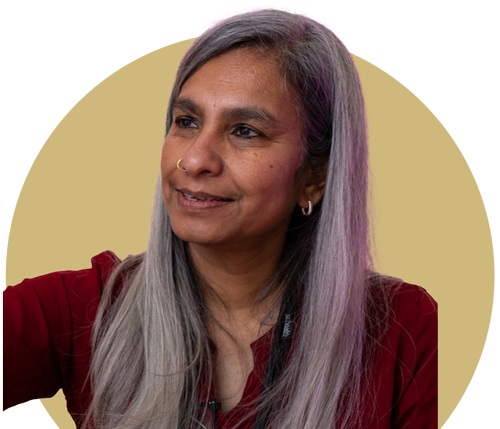Visionary Advances in Eye Care
Momentous advances in eye care are underway at the CU Anschutz Medical Campus. From new devices and next-generation treatments for blinding diseases, to applications for artificial intelligence in diagnostics and care, our faculty are spearheading solutions and delivering hope.
With over $16 million in research funding over the past two years and more than 60 patents since 2020, the Department of Ophthalmology is a powerhouse of innovation. And as the sole academic eye center in Colorado, serving nearly 115,000 patients each year, the Sue Anschutz-Rodgers Eye Center offers the latest and best in eye care.
Here we highlight some of the advancements and technologies reshaping eye care and bringing new sight-saving possibilities into view.
Targeting Glaucoma
“Our pioneering CU-born platform has the potential to change the way we practice ophthalmology around the world.” - Malik Kahook, MD

A groundbreaking drug delivery platform developed by Malik Kahook, MD, at the Sue Anschutz-Rodgers Eye Center is transforming the treatment of eye diseases, including glaucoma.
Glaucoma is a leading cause of vision loss and blindness, causing irreversible damage to the optic nerve. While there is no cure for glaucoma, the disease can be treated with eye drops, medication and surgery.
The platform developed by Dr. Kahook treats the disease differently ‒ using an intraocular device to gradually release highly targeted pharmaceuticals within the eye that can slow disease progression with minimal side effects.
The technology marks a leap forward in glaucoma treatment and offers a promising new option for patients with devastating diseases of the eye.
“Our pioneering CU-born platform has the potential to change the way we practice ophthalmology around the world,” Dr. Kahook said. “The University of Colorado is absolutely the best possible place for innovation. I feel like we are just getting started.”
Saving & Restoring Sight
“Restoring vision in AMD patients is a big dream, but we are continuously moving closer to that being a reality.” - Valeria Canto-Soler, PhD

Valeria Canto-Soler, PhD, and her team are bringing new hope to people with blinding diseases, such as age-related macular degeneration (AMD). The team at CellSight is making exciting inroads using stem cell-based technology to save and restore human sight.
By growing miniature 3D human retinas in the lab, the team has sped noninvasive drug testing and developed a breakthrough clinical product that could one day be transplanted into humans. The never-before-attempted retinal transplant approach is showing promising preliminary results. If successful, the transplant could replace retinal cells lost during AMD.
“The nature of the transplant that we are developing is unique, so we had to go from zero,” said Dr. Canto-Soler. “Restoring vision in AMD patients is a big dream, but we are continuously moving closer to that being a reality.”
With three patents, 12 more under review, an Anschutz Acceleration Initiative award and top National Eye Institute prizes under their belt, the team is taking its technology to the next level ‒ ultimately, closer to therapeutic use in patients awaiting life-changing solutions.
AI in Eye Care
“We need to think about what humans are good at versus what computers are good at to ultimately improve the art and science of medicine.” - Jayashree Kalpathy-Cramer, PhD

Artificial intelligence (AI) is bringing better diagnostics and care into reach at CU Anschutz, and Jayashree Kalpathy-Cramer, PhD, is leading the charge. Because ophthalmology relies heavily on imaging, it is well-suited to AI technologies.
By building algorithms to diagnose macular degeneration and glaucoma and screen for blinding diseases in infants, Dr. Kalpathy-Cramer is working to integrate AI into medicine ‒ paving the way toward more standardized, proactive approaches to healthcare.
“Instead of thinking of AI as replacing doctors, we need to think about what humans are good at versus what computers are good at to ultimately improve the art and science of medicine,” she said. “Our true measure of success will be determined by the impact our work has on the health of the patients we serve.”
Beyond diagnosing eye disease, AI is proving effective in detecting a host of factors that impact human health ‒ an area of investigation furthered by a recent Anschutz Acceleration Initiative award.
“With a picture of the eye, an algorithm can tell if you are male or female, how old you are, whether you smoke, what your risk of cardiovascular diseases are, and what your risk of Alzheimer’s or Parkinson’s is,” Dr. Kalpathy-Cramer said. “The range of possibilities is absolutely enormous.”
By building algorithms to diagnose macular degeneration and glaucoma and screen for blinding diseases in infants, Dr. Kalpathy-Cramer is working to integrate AI into medicine ‒ paving the way toward more standardized, proactive approaches to healthcare.
“Instead of thinking of AI as replacing doctors, we need to think about what humans are good at versus what computers are good at to ultimately improve the art and science of medicine,” she said. “Our true measure of success will be determined by the impact our work has on the health of the patients we serve.”
Beyond diagnosing eye disease, AI is proving effective in detecting a host of factors that impact human health ‒ an area of investigation furthered by a recent Anschutz Acceleration Initiative award.
“With a picture of the eye, an algorithm can tell if you are male or female, how old you are, whether you smoke, what your risk of cardiovascular diseases are, and what your risk of Alzheimer’s or Parkinson’s is,” Dr. Kalpathy-Cramer said. “The range of possibilities is absolutely enormous.”
Sincerely,

Don Elliman